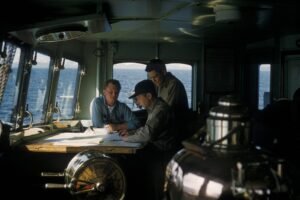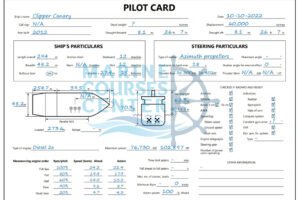
Navigating the Open Seas: A Closer Look at Ship Alarms for Emergency Situations
Table of Contents

Navigating the Open Seas: A Closer Look at Ship Alarms for Emergency Situations
Introduction to Ship Alarms for Emergency Situations
When sailing the open seas, preparedness is key. Unforeseen emergencies can arise at any moment, putting both crew members and the vessel itself at risk. That’s why ships are equipped with a range of alarms and signals that serve as crucial communication tools during times of crisis. In this blog post, we’ll explore the various alarm types found on ships and how they contribute to the safety and resilience of maritime operations.
Section 1: The Importance of Ship Alarms for Emergency Situations
Ship alarms play a vital role in ensuring the safety and well-being of everyone on board. They are strategically placed throughout the ship’s systems and machinery to swiftly notify the crew about potential dangers and emergencies. By adhering to established procedures and staying vigilant, crew members can quickly respond to these alarms and take necessary actions to mitigate risks.
One of the most critical signals on a ship is the general emergency alarm. Recognized by seven short bell rings followed by one long ring, or seven short blasts on the ship’s horn followed by one long blast, this alarm is sounded to alert the crew about emergencies such as fire outbreaks, collisions, groundings, or situations warranting abandoning the ship. It serves as a clear and standardized signal that ensures a consistent understanding of emergency situations, regardless of the vessel’s location or company affiliation.
Section 2: Key Ship Alarms for Emergency Situations Types
Now let’s take a closer look at some specific alarm types on ships:
1. Fire Alarm
Fire safety is of paramount importance on a ship. In case of a fire, crew members can raise the fire alarm by pressing a nearby fire switch or vocally shouting “FIRE FIRE FIRE.” The ship’s fire alarm signal consists of continuous ringing of the electrical bell or the ship’s horn for at least 10 seconds. This urgent alert prompts crew members to swiftly respond to the fire outbreak, proceed to fire stations, and execute duties as assigned in the muster list.
2. Man Overboard Alarm
In situations where a crew member or passenger falls overboard, the man overboard (MOB) alarm is activated. This alarm comprises three long rings of the ship’s internal alarm bell to notify onboard crew members. Simultaneously, three long blasts on the ship’s whistle alert other vessels in the vicinity. Additionally, a man overboard signal with light and smoke can be deployed to attract attention and aid in rescue efforts. Upon hearing the MOB alarm, crew members must respond promptly and follow established procedures to aid the individual in distress.
Section 3: Ensuring Safe Navigation
Safe navigation is a top priority in the maritime industry. The navigation bridge, the ship’s command center, is equipped with navigational alarms to alert the crew about any equipment malfunctions or failures that could compromise safety. These alarms appear on the navigation panel’s notification screen, providing crucial information about the affected equipment and problem type. Upon receiving a navigational alarm, crew members must investigate the issue, locate the fault, and take corrective action as required.
Another crucial area in need of alarms is the engine room, which houses critical machinery. Machinery space alarms trigger when malfunctions occur in the engine room’s equipment, ensuring safe engine operations. Upon hearing a machinery space alarm, crew members must identify the specific machinery or system involved, diagnose the fault, and initiate corrective measures.
Conclusion
Ship alarms are lifelines during emergencies, enabling rapid response and safeguarding lives and assets onboard. By understanding and recognizing the different alarm types on a ship, every seafarer can contribute to the safety and resilience of maritime operations. So, the next time you set sail on the open seas, rest assured that a robust alarm system stands ready to keep you safe.
What is the purpose of ship alarms in emergency situations?
Ship alarms are essential communication tools that quickly notify the crew about potential dangers and emergencies, allowing them to take necessary actions to mitigate risks.
Ship alarms are essential communication tools that quickly notify the crew about potential dangers and emergencies, allowing them to take necessary actions to mitigate risks.
Ship alarms are essential communication tools that quickly notify the crew about potential dangers and emergencies, allowing them to take necessary actions to mitigate risks.
Ship alarms are essential communication tools that quickly notify the crew about potential dangers and emergencies, allowing them to take necessary actions to mitigate risks.
Ship alarms are essential communication tools that quickly notify the crew about potential dangers and emergencies, allowing them to take necessary actions to mitigate risks.
What is the purpose of the man overboard alarm, and how is it signaled?
he man overboard (MOB) alarm is activated when a crew member or passenger falls overboard. It involves three long rings of the ship’s internal alarm bell to notify onboard crew members and three long blasts on the ship’s whistle to alert nearby vessels. Light and smoke signals can also be used to aid rescue efforts.
What is the role of navigational alarms on a ship, and where are they displayed?
Navigational alarms alert the crew about equipment malfunctions or failures that could compromise safety. They appear on the navigation panel’s notification screen in the navigation bridge, helping crew members identify affected equipment and take corrective actions.
How do machinery space alarms contribute to maritime safety, and what should crew members do upon hearing one?
Machinery space alarms in the engine room trigger when equipment malfunctions occur. They ensure safe engine operations. Upon hearing a machinery space alarm, crew members must identify the specific machinery or system involved, diagnose the issue, and initiate corrective measures.
Leave A Reply
You must be logged in to post a comment.




1 Comment